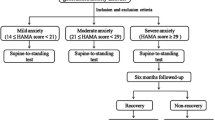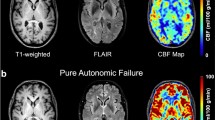Abstract
Objective
Cerebral autoregulation (CA) is the mechanism by which constant cerebral blood flow is maintained despite changes in cerebral perfusion pressure. CA can be evaluated by dynamic monitoring of cerebral blood flow velocity (CBFV) with transcranial Doppler sonography (TCD). The present study aimed to explore CA in chronic anxiety.
Methods
Subjects with Hamilton anxiety scale scores ≥14 were enrolled and the dynamic changes of CBFV in response to an orthostatic challenge were investigated using TCD.
Results
In both the anxious and the healthy subjects, the mean CBFV was significantly lower in the upright position than when supine. However, the CBFV changes from supine to upright differed between the anxious and the healthy groups. Anxious subjects showed more pronounced decreases in CBFV with abrupt standing.
Conclusion
Our results indicate that cerebrovascular modulation is compromised in chronic anxiety; anxious subjects have some insufficiency in maintaining cerebral perfusion after postural change. Given the fact that anxiety and impaired CA are associated with cardiovascular disease, early ascertainment of compromised cerebrovascular modulation using TCD might suggest interventional therapies in the anxious population, and improve the primary prevention of cardiovascular disease.
Similar content being viewed by others
References
Hasler G, Fromm S, Alvarez RP, Luckenbaugh DA, Drevets WC, Grillon C. Cerebral blood flow in immediate and sustained anxiety. J Neurosci 2007, 27: 6313–6319.
Licht CM, de Geus EJ, van Dyck R, Penninx BW. Association between anxiety disorders and heart rate variability in The Netherlands Study of Depression and Anxiety (NESDA). Psychosom Med 2009, 71: 508–518.
Yeragani VK, Tancer M, Seema KP, Josyula K, Desai N. Increased pulse-wave velocity in patients with anxiety: implications for autonomic dysfunction. J Psychosom Res 2006, 61: 25–31.
Willie CK, Colino FL, Bailey DM, Tzeng YC, Binsted G, Jones LW, et al. Utility of transcranial Doppler ultrasound for the integrative assessment of cerebrovascular function. J Neurosci Methods 2011, 196: 221–237.
Olufsen MS, Ottesen JT, Tran HT, Ellwein LM, Lipsitz LA, Novak V. Blood pressure and blood flow variation during postural change from sitting to standing: model development and validation. J Appl Physiol 2005, 99: 1523–1537.
Panerai RB, Dawson SL, Eames PJ, Potter JF. Cerebral blood flow velocity response to induced and spontaneous sudden changes in arterial blood pressure. Am J Physiol Heart Circ Physiol 2001, 280: H2162–2174.
Guo ZN, Xing Y, Yang L, Huang Y, Zhang L, Luan SX, et al. Elementary study about the supine-standing cerebral blood flow in patients with anxiety. J Apoplexy Nerv Dis 2011, 28: 50–52. [Article in Chinese]
Czajkowska J, Ozhog S, Smith E, Perlmuter LC. Cognition and hopelessness in association with subsyndromal orthostatic hypotension. J Gerontol A Biol Sci Med Sci 2010, 65: 873–879.
Xu WH, Wang H, Wang B, Niu FS, Gao S, Cui LY. Disparate cardiocerebral vascular modulation during standing in multiple system atrophy and Parkinson disease. J Neurol Sci 2009, 276: 84–87.
Diehl RR. Cerebral autoregulation studies in clinical practice. Eur J Ultrasound 2002, 16: 31–36.
Silvestrini M, Vernieri F, Pasqualetti P, Matteis M, Passarelli F, Troisi E, et al. Impaired cerebral vasoreactivity and risk of stroke in patients with asymptomatic carotid artery stenosis. JAMA 2000, 283: 2122–2127.
Markus H, Cullinane M. Severely impaired cerebrovascular reactivity predicts stroke and TIA risk in patients with carotid artery stenosis and occlusion. Brain 2001, 124: 457–467.
Mense L, Reimann M, Rüdiger H, Gahn G, Reichmann H, Hentschel H, et al. Autonomic function and cerebral autoregulation in patients undergoing carotid endarterectomy. Circ J 2010, 74: 2139–2145.
Rutledge T, Linke SE, Krantz DS, Johnson BD, Bittner V, Eastwood JA, et al. Comorbid depression and anxiety symptoms as predictors of cardiovascular events: results from the NHLBIsponsored Women’s Ischemia Syndrome Evaluation (WISE) study. Psychosom Med 2009, 71: 958–964.
Sardinha A, Araújo CG, Soares-Filho GL, Nardi AE. Anxiety, panic disorder and coronary artery disease: issues concerning physical exercise and cognitive behavioral therapy. Expert Rev Cardiovasc Ther 2011, 9: 165–175.
Coryell W, Noyes R, Clancy J. Excess mortality in panic disorder. A comparison with primary unipolar depression. Arch Gen Psychiatry 1982, 39: 701–703.
Walters K, Rait G, Petersen I, Williams R, Nazareth I. Panic disorder and risk of new onset coronary heart disease, acute myocardial infarction, and cardiac mortality: cohort study using the general practice research database. Eur Heart J 2008, 29: 2981–2988.
Chen YH, Tsai SY, Lee HC, Lin HC. Increased risk of acute myocardial infarction for patients with panic disorder: a nationwide population-based study. Psychosom Med 2009, 71: 798–804.
Frasure-Smith N, Lesperance F. Depression and anxiety as predictors of 2-year cardiac events in patients with stable coronary artery disease. Arch Gen Psychiatry 2008, 65: 62–71.
Yang L, Yang Y, He SY, Xin ZE, Guo ZN. Use of transcranial Doppler sonography to evaluate patients with anxiety disorders before and after treatment. Chin J Lab Diagn 2012; 16: 1324–1325. [Article in Chinese]
Author information
Authors and Affiliations
Corresponding authors
Additional information
These authors contributed equally to this work.
Rights and permissions
About this article
Cite this article
Zhang, HL., Guo, ZN., Yang, G. et al. Compromised cerebrovascular modulation in chronic anxiety: evidence from cerebral blood flow velocity measured by transcranial Doppler sonography. Neurosci. Bull. 28, 723–728 (2012). https://doi.org/10.1007/s12264-012-1282-y
Received:
Accepted:
Published:
Issue Date:
DOI: https://doi.org/10.1007/s12264-012-1282-y




